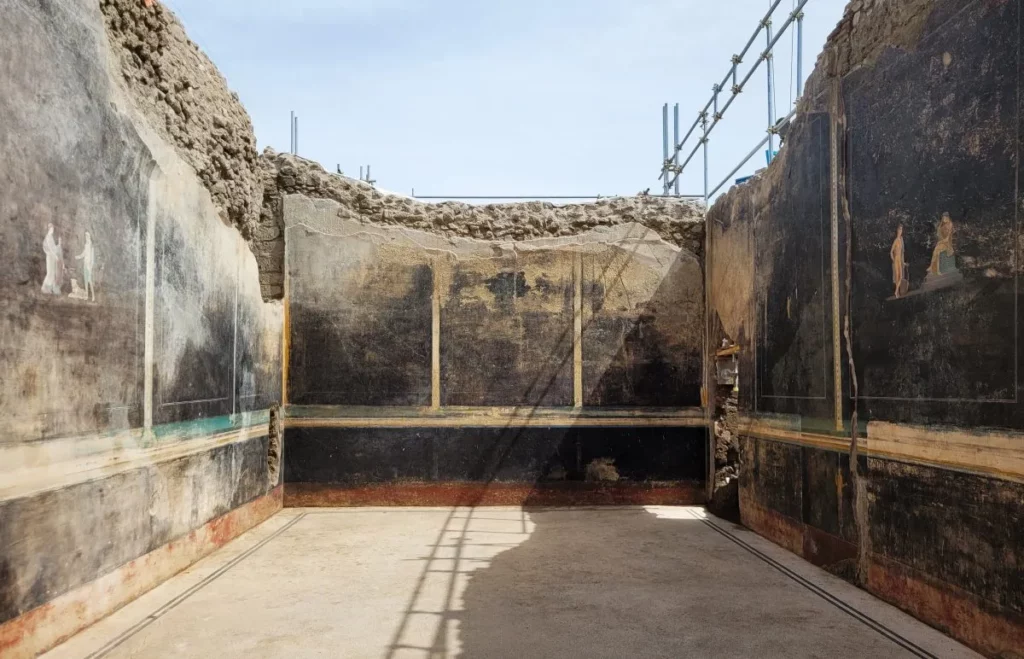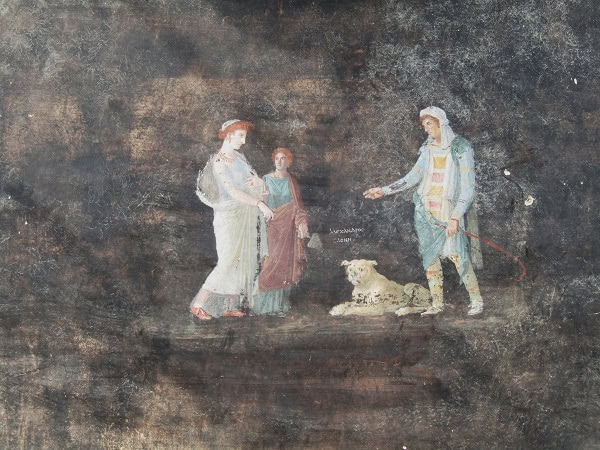Two stunning frescoes depicting mythical figures like Apollo and Helen of Troy tower across a newly-explored part of Pompeii. The frescoes, among the finest ever discovered, were painted on the black walls of a large banquet hall that researchers just uncovered.

A city frozen in time
Pompeii was a flourishing Roman town. It lay at the foot of Mount Vesuvius, near the modern city of Naples in Italy. It was a bustling hub of activity, boasting an array of public baths, forums, and vibrant markets. But in the year 79 AD, that was all brought to a devastating halt.
Mount Vesuvius is a volcano and that eruption was one of the most catastrophic in history. It sent down a lethal combination of ash, pumice, and gases that blanketed the town (and neighboring areas) under a thick layer of debris.
The event killed virtually everyone in Pompeii. But it also froze Pompeii in time. The volcanic blanket preserved the city for centuries, making it one of the most valuable archaeological sites in history.
The town, along with its neighbor Herculaneum, was lost to history until its rediscovery in the 18th century. Since then, excavations have unearthed significant portions of the town, offering invaluable insights into Roman life. However, despite centuries of archaeological efforts, Pompeii continues to guard many secrets beneath its unexcavated areas.
Now, archeologists have found more of what Pompeii has hidden. They’ve uncovered a massive banquet hall with black walls that would have hosted lavish Roman parties.
Party like the Romans
Romans loved their parties, and Pompeii is no exception. They partied day and night — and that’s probably why they painted the walls black. Because the Romans used lamps during the night, the smoke would have likely created sooty marks on the walls. By painting the entire room black, that problem was avoided.

But there was another benefit to the black walls. In the shimmering light from lamps (or twilight), any frescoes on the walls would have “almost come to life,” says Pompeii Park Director Dr. Gabriel Zuchtriegel.
The frescoes depict scenes from Greek mythology, which heavily influenced Roman culture at the time. In one of them, Paris, the prince of Troy, is shown with the Spartan princess Helen — better known as Helen of Troy. This event would trigger the mythical Trojan War, depicted by the Greek poet Homer in the Iliad.
Another fresco shows Apollo, the Greek god of the Sun and the arts, trying to seduce the priestess Cassandra. Cassandra had the gift of prophecy, but Apollo got so mad at her rejection that he cursed her, resulting in her prophecies being ignored.
The banquet hall also featured a stunning mosaic floor that consisted of over a million tiny white tiles, contrasting starkly with the black walls above and creating an imposing visual effect.
And the rest of the household was equally impressive.
The owner had a laundromat, a reception area, and a garden, as well as a dedicated bakery and shrine. In the shrine, archaeologists also found the remains of two adults and a child — probably slaves of the household, who were killed by the Vesuvius eruption.
These people would likely have lived in horrendous conditions. Researchers found clues that they were locked away with animals, presumably only allowed for work or other assigned tasks.
Roman society wasn’t a particularly nice place unless you were super rich.
Plenty more to uncover
For the archaeologists working in Pompeii, finding something as spectacular as this is challenging. Sure, on one hand, it’s a remarkable find, but on the other hand, preserving it isn’t easy. Much of what’s found in Pompeii will be sent to museums, but the frescoes and the banquet hall will be preserved in place. The walls are coming apart, so archaeologists inject a special plaster glue to keep them in place. They’re also using scaffolding and temporary roofing to help protect the room.
At the same time, the research team is expanding their excavation and conservation work. Around a third of Pompeii is still covered in rubble and there’s a lot of work left to be done.
Even when archaeologists clear out the rubble, the work is just starting.
Because Pompeii is such a unique place, it can tell rare stories about what life in ancient Rome was really like. Just a few months ago, three researchers won a $700,000 prize for using artificial intelligence to read a charred 2,000-year-old scroll from the Vesuvius eruption. Plenty of other artifacts warrant closer exploration and restoration, which will undoubtedly take a lot of time and effort to carry out.
The discovery of the magnificent banquet hall in Pompeii, adorned with evocative frescoes and a starkly contrasting mosaic floor, underscores the profound importance of this ancient city as a cultural and historical treasure — and hints at just how much we’ve yet to discover. With roughly a third of the city still buried beneath volcanic debris, the secrets that Pompeii holds are far from fully revealed.






